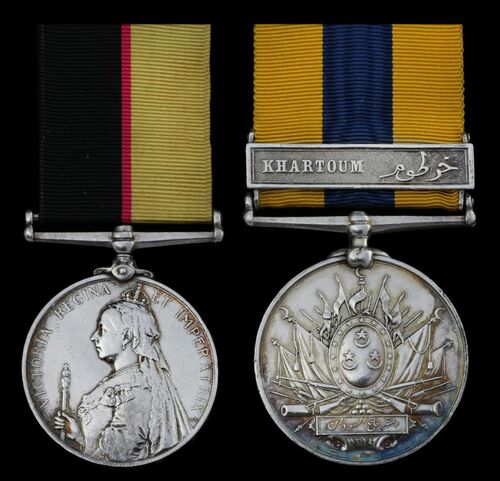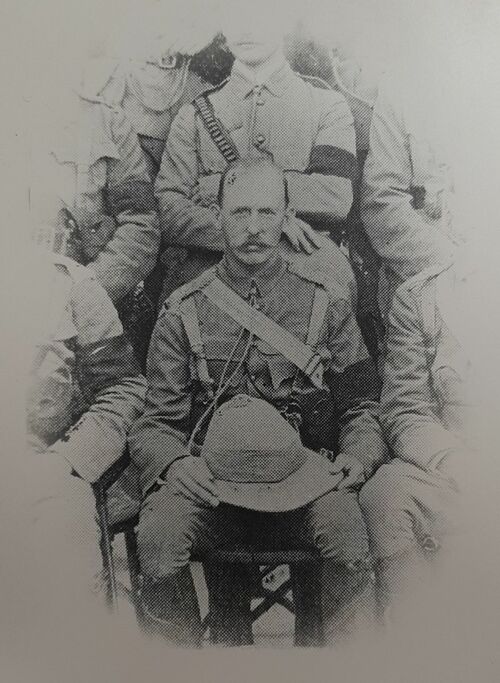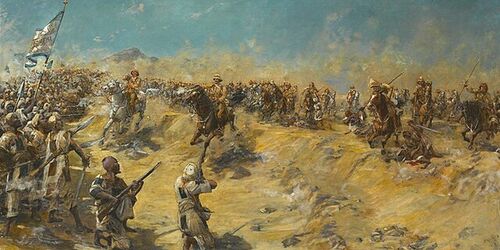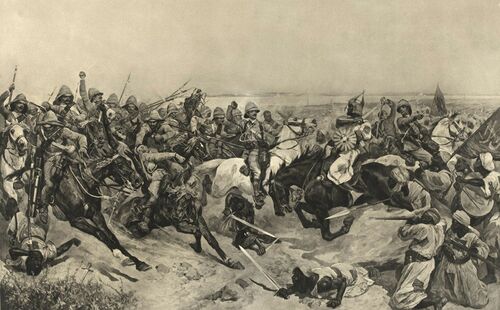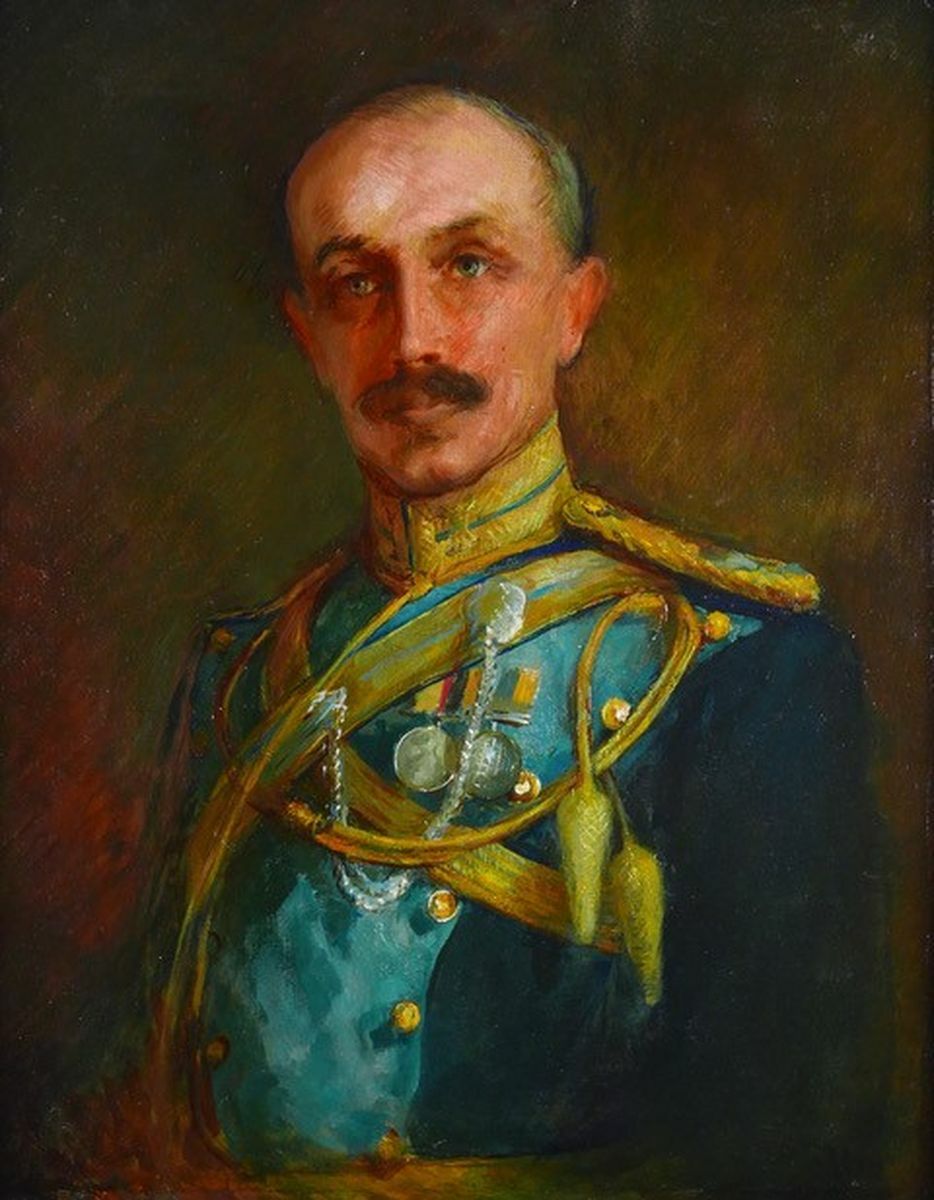Auction: 24112 - Orders, Decorations and Medals - e-Auction
Lot: 389
The superb and unique 'Omdurman Charger's' campaign pair awarded to Captain W. M. Doyne, 21st (Empress of India's) Lancers, who commanded 'C' Squadron during their famous charge on 2 September 1898
Queen's Sudan 1896-98 (Capt. W. M. Doyne. 21/Lancers.); Khedive's Sudan 1896-1908, 1 clasp, Khartoum, unnamed as issued, mounted recently for wear, minor contact wear, very fine, and rare (2)
Provenance:
J. B. Hayward, 1 June 1978.
William Markham Doyne was born at Lewisham on 3 March 1862, the son Major Henry and Mrs Lydia Doyne. Commissioned Second-Lieutenant with the Donegal Militia Artillery on 26 March 1879, he was promoted Lieutenant soon afterwards, on 27 September 1879.
Perhaps seeking a more exciting life than Militia service could provide, Doyne transferred into the 21st Hussars on 27 January 1883, being advanced to Captain on 9 September 1888. The 21st had their origins in the old 'European' units of the East India Company's army - indeed they were only formally moved over to the British Army in 1862 - and had therefore spent most of their existence in India. This is where Doyne would have joined them, and within a few years had made his mark as a somewhat eccentric young officer:
'In May 1894 Captain Doyne gave a dinner-party in his bungalow at which the male guests were invited to "attire themselves as ladies". The party, including Lieutenant de Montmorency in "becoming golden locks" and Lieutenant Smyth "gowned in green and pink and wigged in yellow" dined to the accompaniment of the string band. The following month a Fancy Dress Ball was held and all commanded to dress as officers or ladies of the 1760's, when the regiment was first raised and gentlemen of the 21st wore their hair long or sported wigs...Not enough wigs could be found in Bangalore and telegrams were sent to Bombay, Calcutta and Madras for further supplies. Wigs came in from all parts of the country, but the following notice posted in the Mess disappointed many: "It is a fact that no more white silk-stockings (men's size) can be obtained throughout India".' (The Last Charge - the 21st Lancers at the Battle of Omdurman, 2 September 1898, p. 34-35, refers)
Finally detailed for 'Foreign Service' after many years of garrison duty and the amusements of fancy-dress parties the regiment sailed for Egypt, with Doyne as Officer Commanding 'C' Squadron and in 1897 they were assigned to the Anglo-Egyptian army tasked with the reconquest of the Sudan - in April that same year they were converted from Hussars to Lancers, thence being known as the 21st Lancers.
Despite their lack of combat experience the Commanding Officer, Colonel Martin, trained his men hard for the perils of desert warfare which included manoeuvring squadrons at speed, training over 300 Arab horses, turning out "on alarm" with campaign equipment and desert rations in less than one hour, and route marches through the desert; the 21st also received notification that eight new officers were to be attached to them for the upcoming campaign and one of that number, who was already gaining an initially chequered reputation - was a Lieutenant Winston Spencer Churchill of the 4th Hussars.
The only British cavalry regiment in Kitchener's force, the regiment rode with the Sirdar's army in the direction of Omdurman, on the banks of the river Nile, where they initially undertook the traditional light cavalry role of scouting ahead of the main force; at the battle of Omdurman, on the morning of 2 September, Kitchener's infantry and artillery cut the attacking Dervishes to pieces - in 30 minutes the Khalifa's army lost 2,000 dead and 4,000 wounded for less than 60 British and Egyptian casualties. The 21st Lancers had been mere spectators, but their moment of glory was soon to come.
At 7.30am, the regiment were sent out on reconnaisance towards Omdurman itself, to check the route Kitchener intended to take with his army; small patrols were sent out and that under the command of Lieutenant Pirie encountered a Dervish force, estimated at 1,000 strong, blocking the main road. Reporting back to Colonel Martin, the Commanding Officer decided now was the time to strike and ordered the regiment into the trot: Doyne and 'C' Squadron were at the head of the column, with 'D', 'B' and 'A' riding behind them in that order. Coming under fire as they passed the Mahdist line, the 21st they swung from column of Troops into line, and prepared to charge.
'The whole regiment - all sixteen troops - turned neatly to face the knot of Beja on the ridge three hundred yards away. Martin spurred his horse on and led his men from the centre, thirty yards in front. Looking back, he saw his massed ranks of horsemen, helmets cocked across their eyes, lance-tips and sabres gleaming, leap forward at the gallop, into what would be the last regimental cavalry charge in British military history'. (Khartoum: The Ultimate Imperial Adventure, Michael Asher, refers). It was at this point as the line connected with the tribesmen that the full dire nature of their position became clear. A much larger force of Dervish infantry, some 2,000 spearmen, were positioned in a hidden watercourse behind the thinnly-populated skirmish line:
'The pace was fast and the distance short. Yet, before it was half covered, the whole aspect of the affair changed. A deep crease in the ground - a dry watercourse, a khor - appeared where all had seemed smooth, level plain; and from it there sprang, with the suddenness of a pantomime effect and a high pitched yell, a dense white mass of men nearly as long as our front and about twelve deep. A score of horsemen and a dozen bright flags rose as if by magic from the earth. Eager warriors sprang forward to anticipate the shock. The rest stood firm to meet it. The Lancers acknowledged the apparition only by an increase of pace. Each man wanted sufficient momentum to drive through such a solid line. The flank troops, seeing that they overlapped, curved inwards like the horns of the moon. But the whole event was a matter of seconds.' (The River War, Winston Churchill, refers)
The sudden appearance of the enemy did not cause the lancers to withdraw and instead they pressed on into the enemy ranks: 'The Last Charge' outlines the attack from Doyne's perspective:
'Captain Doyne's C Squadron entered the Khor where the Dervishes were spread most thinly, and all who remained mounted got through, although several suffered spear wounds. However, any man who was unhorsed had little chance of escape. Private Ayton, without pulling up his own mount, rescued an unhorsed man by grasping and dragging him through the enemy and out of the khor'. It was an officer of 'C' Squadron whose rescue earned Private Byrne the Victoria Cross during the engagement:
'Lieutenant Molyneux had his horse killed beneath him and continued on foot, racing for the far side of the khor. Dervishes closed across his path and the first sword blow left a deep cut across his right hand; his pistol fell to the ground, and a second blow was likely to prove fatal. Looking round frantically for help, Molyneux found that the easy passage offered his troop meant that he stood alone. He dodged several sword blows from the four dervishes surrounding him, buying precious seconds but finding no escape. At this moment a private rode in from the right, his lance gone, his sword arm badly wounded, heading for the far bank of the khor. Molyneux called out for help; without hesitation Private Byrne replied, "All right, Sir, I won't leave you!", and turned his horse back.'
Those of the 21st who survived their mad charge through the enemy line managed to reform behind the Dervishes and draw their carbines. Any attempt at pursuit was met by a furious fire which eventually broke the enemy and sent them running; this ended the threat to the British left. In the interim Hector MacDonald's Sudanese Brigade routed the Khalifa's Black Standard Division, leaving the battle all but a forgone conclusion.
Promoted to Major on 26 October 1898, Doyne returned to the United Kingdom not long after the battle. He appears on the 1901 census at Marlborough Barracks, Dublin, and retired on 7 May 1902. Settling initially in his father's home county of Donegal, Ireland, Doyne married in Pembrokeshire, Wales, and in 1912 moved to Mowden Hall, Hatfield Peverel, Essex, where he died on 28 December 1924; sold together with handwritten research and an original receipt from J. B. Hayward.
A portrait in oils of Captain Doyne was recently sold by the Armoury of St. James's, of Piccadilly Arcade, London.
Subject to 20% VAT on Buyer’s Premium. For more information please view Terms and Conditions for Buyers.
Sold for
£9,500
Starting price
£5800

